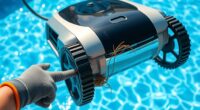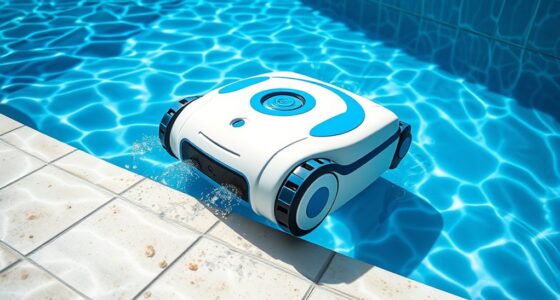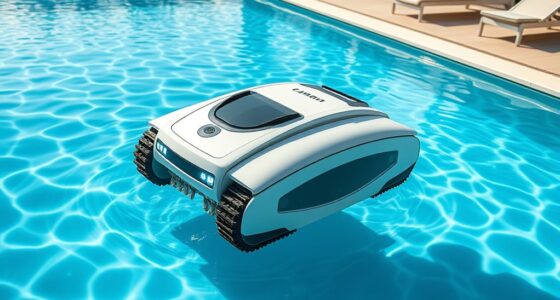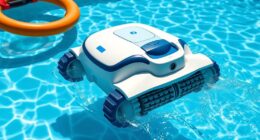To care for your cordless robotic pool cleaner’s battery, use the right charger and avoid full discharges; instead, keep the battery between 20-80%. Store it in a cool, dry place and partially charged if not in use for a while. Watch for signs of wear like reduced runtime or leaks, and replace or recycle it properly when needed. Taking these steps helps extend battery life—learn more to keep your cleaner performing at its best.
Key Takeaways
- Use the manufacturer’s recommended charger and avoid overcharging to maintain battery health.
- Store batteries in a cool, dry place and keep them partially charged (40-60%) during inactivity.
- Regularly inspect for signs of damage, leakage, or corrosion, and replace batteries when performance declines.
- Avoid deep discharges and extreme temperatures to prolong battery lifespan and efficiency.
- Recycle old batteries responsibly through designated disposal programs to ensure environmental safety.
Understanding Your Battery Type and Specifications
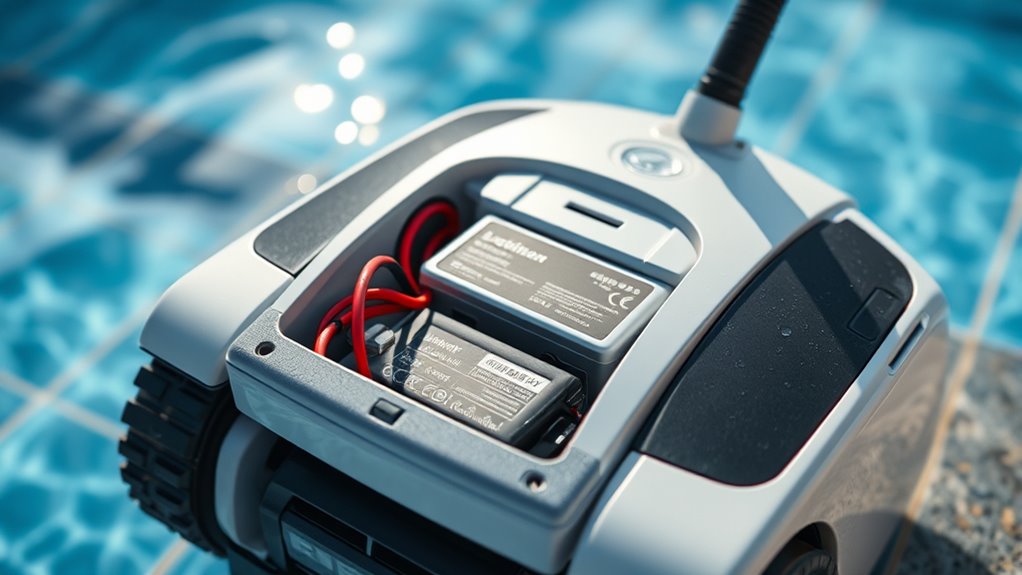
To properly care for your cordless robotic pool cleaner’s battery, it’s essential to understand the type and specifications of the battery it uses. Knowing the battery chemistry, such as lithium-ion or NiMH, helps you grasp how it charges, discharges, and ages over time. Lithium-ion batteries are common because of their high energy density and longer lifespan, while NiMH offers affordability but shorter cycle life. Capacity ratings, usually measured in milliamp-hours (mAh) or amp-hours (Ah), indicate how much energy the battery can store. Higher capacity ratings provide longer cleaning sessions between charges. Familiarizing yourself with these specifications ensures you handle the battery correctly, avoid damage, and optimize its performance and lifespan. Additionally, understanding battery maintenance practices can significantly extend the life of your rechargeable power source, especially by monitoring charge cycles and avoiding complete discharges. Regularly following manufacturer guidelines for battery care can prevent issues like capacity loss or overheating, ensuring safe and efficient operation. Being aware of the battery chemistry also helps you select appropriate storage conditions, which are crucial for maintaining optimal performance over time.
Proper Charging Techniques for Longevity
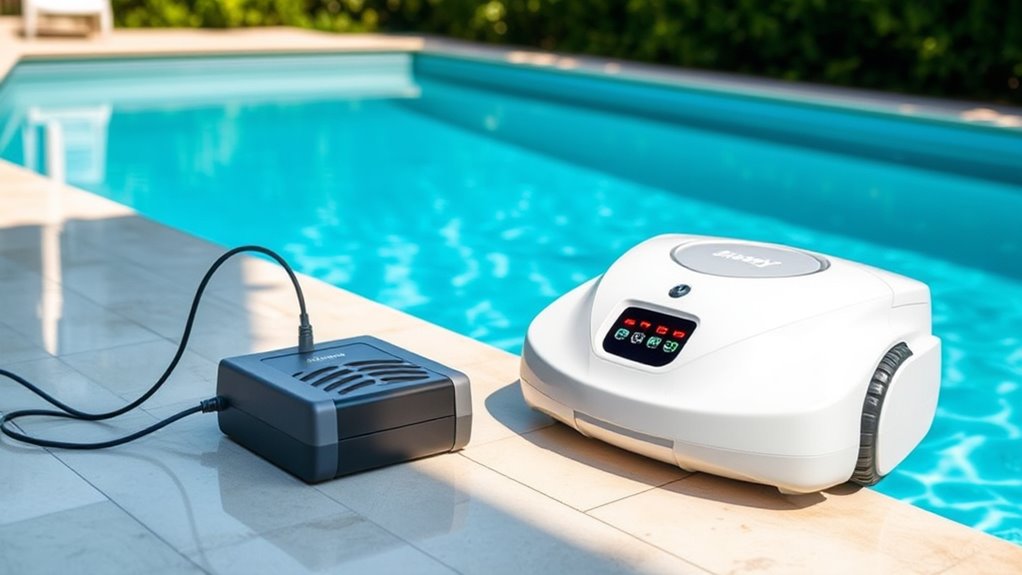
Proper charging techniques can considerably extend the lifespan of your cordless robotic pool cleaner’s battery. To guarantee maximum performance, keep these tips in mind:
- Always use a charger compatible with your battery to prevent damage and ensure proper charging. Check the manufacturer’s specifications for charger compatibility.
- Avoid frequent full discharges; instead, keep the battery between 20% and 80% to reduce wear.
- Perform regular battery calibration by fully charging and draining the battery periodically, which helps maintain accurate battery capacity readings. This practice is especially important for maintaining reliable battery capacity over time.
- Understanding the importance of fatherhood and its impact can inspire you to care for your device as well as your loved ones. Proper battery maintenance can prevent capacity loss and improve overall device reliability.
Following these steps helps prevent overcharging and preserves battery health, ultimately extending its lifespan. Proper charging not only boosts performance but also saves you money in the long run.
Optimal Storage Conditions When Not in Use

When you’re not using your robotic pool cleaner, storing the battery properly is key to maintaining its health. Keep it in a cool, dry place and avoid direct sunlight, which can damage the cells. Also, guarantee the battery is kept partially charged to prevent capacity loss over time. To ensure long-term performance, regularly check the battery’s condition and recharge if it becomes fully discharged. Battery maintenance is essential for preserving battery life and optimal operation. Additionally, following manufacturer guidelines for storage can further prevent capacity degradation and extend the overall lifespan of the battery. Proper environmental conditions, such as avoiding excessive humidity or temperature fluctuations, can further safeguard the battery against unexpected damage and prevent corrosion. Maintaining suitable storage conditions aligns with battery science, which emphasizes the importance of appropriate environmental factors in prolonging battery health.
Store in Cool, Dry Place
Storing your cordless robotic pool cleaner in a cool, dry place helps preserve its battery life and overall performance. Proper temperature regulation prevents the battery from overheating or freezing, which can damage the battery casing. To guarantee ideal storage, consider these tips:
- Keep it in a shaded area away from direct sunlight to avoid temperature spikes.
- Store it in a well-ventilated space to prevent moisture buildup that could affect the battery.
- Avoid places with extreme temperatures, like garages or sheds, which can harm the battery’s integrity.
- Select storage locations that align with optimal storage conditions for battery maintenance to ensure longevity. Additionally, understanding trust issues in relationships can help you address concerns about reliability and commitment, ensuring peace of mind during your storage routines. Maintaining a consistent environment is also key to preventing battery degradation caused by fluctuating temperatures, which aligns with the importance of AI in Business for ensuring reliable and efficient operations.
Keep Battery Partially Charged
Keeping your cordless robotic pool cleaner’s battery partially charged when not in use helps maintain its health and longevity. Aim to keep the battery around 40-60% charged, as this prevents over-discharge or overcharge, which can damage the cells. Regular voltage monitoring ensures the battery stays within safe limits, avoiding voltage fluctuations that could affect performance. Periodic battery calibration is also essential, especially if you notice inaccurate charge readings; calibrate by fully charging and then fully discharging the battery once in a while. This process helps the device’s internal system accurately gauge the battery’s capacity, guaranteeing ideal operation when you need it. Proper storage of a partially charged battery reduces stress on the cells and preserves its capacity over time. Additionally, understanding battery health maintenance can offer tips on maintaining high-quality device care and longevity. Maintaining a stable charge cycle is crucial for optimal battery performance over time.
Avoid Direct Sunlight Exposure
Exposing your cordless robotic pool cleaner’s battery to direct sunlight can cause overheating and accelerate capacity loss. Solar heating increases the battery’s temperature, leading to faster degradation. To protect your battery and maintain ideal performance, consider these tips:
- Store your cleaner in a shaded area away from direct sunlight to prevent unnecessary solar heating.
- Keep it in a cool, dry spot to avoid temperature fluctuations that could harm the battery.
- Ensure the water filtration system is turned off and the cleaner is dry before storage to prevent moisture damage.
Recognizing Signs of Battery Wear and Damage

If your cordless robotic pool cleaner starts to run less efficiently or takes longer to complete its cleaning cycle, it could be a sign of battery wear or damage. Over time, the battery’s lifespan diminishes, leading to decreased performance. You might notice the cleaner struggles to hold a charge or shuts off unexpectedly. Poor charging habits, like frequently overcharging or letting the battery drain completely, can accelerate wear and cause damage. Also, swollen or leaking batteries are clear signs of deterioration. If you observe reduced runtime, inconsistent power, or physical damage, it’s time to evaluate your charging routines and consider replacing the battery. Recognizing these signs early helps maintain ideal performance and prolongs the overall life of your pool cleaner’s battery.
Best Practices for Battery Maintenance During Use
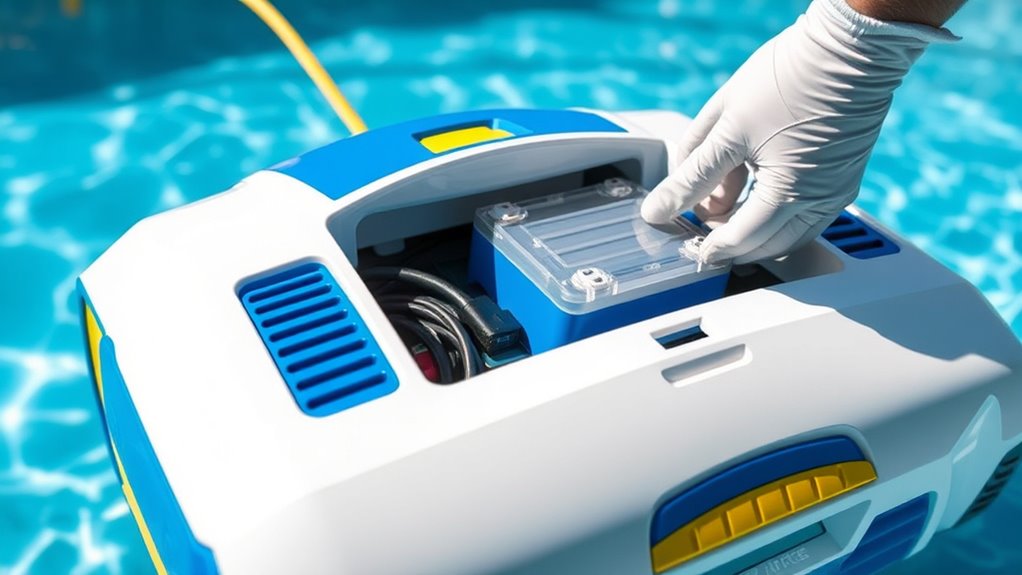
To guarantee your cordless robotic pool cleaner’s battery stays healthy during operation, it’s important to follow proper maintenance practices while using it. Understanding battery chemistry helps you optimize charging habits, especially since different chemistries respond uniquely to use. Here are some best practices:
- Limit charging cycles by unplugging the device once fully charged, preventing overcharging that can reduce battery lifespan.
- Avoid letting the battery drain completely before recharging, as shallow discharge cycles are gentler on most chemistries.
- Use the recommended charger and avoid quick-charging, which can stress the battery and shorten its life.
Following these tips helps preserve battery health, ensuring your cleaner performs reliably over time.
Troubleshooting Common Battery-Related Issues
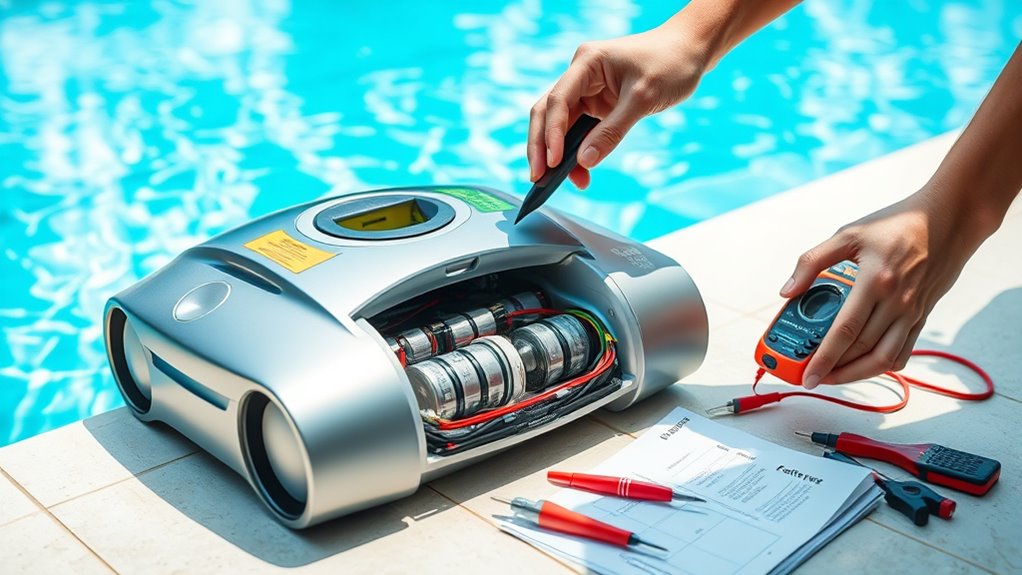
If your robotic pool cleaner isn’t holding a charge or runs out quickly, you might need to extend your battery’s lifespan or fix charging issues. Addressing common problems early can save you time and prevent costly replacements. Let’s explore practical steps to troubleshoot these battery-related challenges effectively.
Battery Life Extension
Battery life can diminish over time due to common issues like improper charging habits or prolonged disuse. To extend your battery’s performance and maintain its capacity, follow these tips:
- Charge your robotic pool cleaner fully before use and avoid partial charges, which can degrade the battery over time.
- Store the device in a cool, dry place when not in use for extended periods to prevent capacity loss.
- Regularly run the cleaner to keep the battery active, as long periods of inactivity can reduce overall battery performance.
Fixing Charging Problems
Charging problems are a common cause of reduced battery performance in cordless robotic pool cleaners. If your device isn’t charging properly, start by checking the charger and power source. Faulty chargers or loose connections can interrupt the charging process. Also, consider the battery chemistry; some batteries degrade faster if exposed to extreme temperatures or improper charging habits. Over time, repeated charging cycles can weaken the battery, leading to longer charging times or failure to hold a charge. To troubleshoot, try resetting the cleaner, cleaning charging contacts, and ensuring you aren’t overcharging or discharging the battery completely. If issues persist, replacing the battery or consulting the manufacturer might be necessary. Proper handling of charging cycles helps maintain ideal battery health and performance.
Replacing and Recycling Your Pool Cleaner Battery
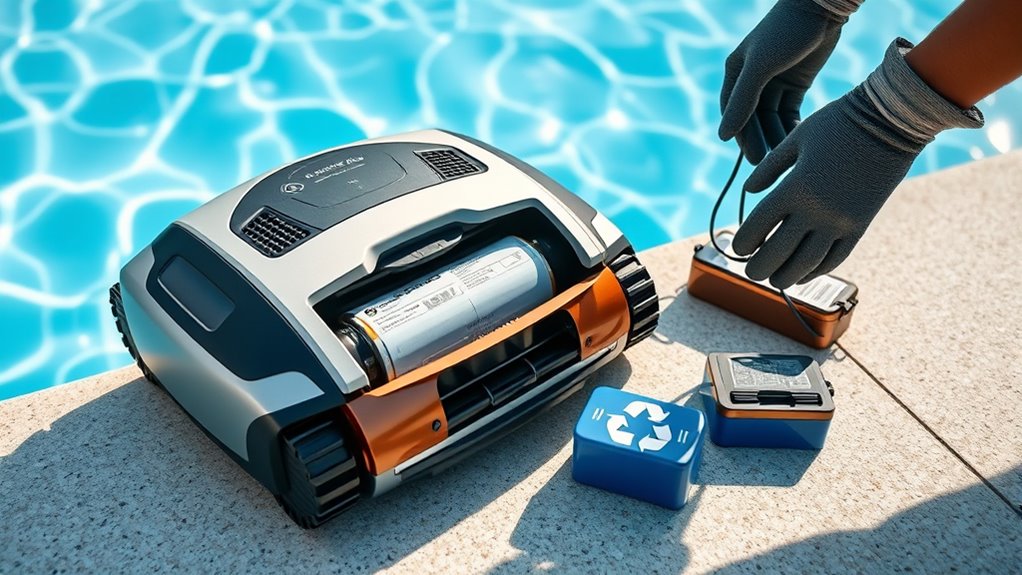
When it’s time to replace your pool cleaner’s battery, handling the process carefully guarantees safety and peak performance. First, identify the battery chemistry—whether lithium-ion or NiMH—as this affects replacement and recycling methods. Next, dispose of your old battery responsibly through recycling programs designed for electronic waste. Here’s what to do:
- Remove the battery carefully, following your manufacturer’s instructions.
- Check local recycling centers or programs that accept pool cleaner batteries.
- Install the new battery, ensuring compatibility and proper connections.
Recycling programs help prevent environmental harm and recover valuable materials. Always prioritize safety during removal and disposal. Proper handling extends your pool cleaner’s lifespan and supports eco-friendly practices.
Frequently Asked Questions
How Often Should I Replace My Robotic Pool Cleaner’S Battery?
You should replace your robotic pool cleaner’s battery when its lifespan diminishes, usually after 2-3 years with proper care. Keep an eye on battery performance—if it doesn’t hold charge or runs out quickly, it’s time for a replacement. Proper battery disposal is essential; never toss it in the trash. Regularly maintaining your battery guarantees peak performance and safety, extending its life and reducing environmental impact.
Can I Upgrade to a Higher-Capacity Battery for Longer Cleaning Sessions?
Think of your pool cleaner’s battery like a backpack—more capacity means more gear for the hike. Upgrading to a higher-capacity battery can extend your cleaning sessions, but check if your model supports charging upgrades or larger batteries. Not all models are compatible, so consult the manufacturer or a professional. If it fits, you’ll enjoy longer, uninterrupted cleanings without constantly recharging.
Is It Safe to Leave the Battery Charging Overnight?
You’re wondering if it’s safe to leave the battery charging overnight. While many devices are designed with safety features, it’s best to verify your specific robotic pool cleaner’s instructions. Proper battery charging ensures overnight safety, but always use the charger provided and avoid leaving it unattended for extended periods. If unsure, unplug the device once it’s fully charged to minimize risks and prolong battery life.
What Environmental Factors Can Degrade Battery Performance Quickly?
They say “a chain is only as strong as its weakest link,” and environmental factors can quickly weaken your battery. Solar interference can disrupt charging and degrade performance, while chemical exposure from pool chemicals can cause corrosion and damage. To keep your battery healthy, avoid direct sunlight and chemical spills, and store it in a cool, dry place. Proper care guarantees your cordless robotic pool cleaner runs smoothly for longer.
Are There Specific Brands of Batteries Recommended for My Model?
You should check your pool cleaner’s manual for recommended brands, as brand compatibility plays a key role in ensuring ideal battery lifespan. Using compatible batteries prevents damage and maintains performance. Stick with trusted brands known for quality, and avoid off-brand options that may not fit properly or deliver consistent power. Properly matching your cleaner’s specifications helps extend battery life and keeps your device running smoothly over time.
Conclusion
Taking good care of your cordless robotic pool cleaner’s battery isn’t just about extending its life—some say it also boosts performance and safety. While the theory that proper maintenance prevents early failure holds true, it’s worth noting that batteries naturally degrade over time. By following these tips, you’re not only protecting your investment but also ensuring a cleaner, safer pool. Stay attentive, and your cleaner will serve you well for years to come.

